
The course is aimed to develop problem-solving strategies, techniques and skills that can be applied to computers and problems in other areas which give students an introduction to computer and analytical skills to be used in their subsequent course work and professional development. Emphasis of this course is to act as an introduction to the thinking world of computers, to help students develop the logic, ability to solve the problems efficiently using C programming. Knowledge in a programming language is prerequisite to the study of most of computer science courses. This knowledge area consists of those skills and concepts that are essential to problem-solving and programming practice independent of the underlying paradigm. Student will learn various concepts and techniques for problem-solving and will implement those ideas using C programming.
Problem - Solving Techniques Steps for Problem - Solving Using Computer as a Problem-Solving Tool Design of Algorithms Definition Features of Algorithm Criteria to be followed by an Algorithm Top Down Design Analysis of Algorithm Efficiency Redundant Computations Referencing Array Elements Inefficiency Due to Late Termination o Early Detection of Desired Output Condition o Trading Storage for Efficient Gains Analysis of Algorithm Complexity Computational Complexity o The Order of Notation o Rules for using the Big - O Notation o Worst and Average Case Behavior Flowcharts Basic Symbols used in Flowchart Design
Unit 2: Basics of CWhat is a Program and what is a Programming Language? C Language History of C Salient Features of C Structure of a C Program A Simple C Program Writing a C Program Compiling a C Program The C Compiler Syntax and Semantic Errors Link and Run the C Program Run the C Program through the Menu Run from an Executable File o Linker Errors o Logical and Runtime Errors Diagrammatic Representation of Program Execution Process
Unit 3 : Variables and ConstantsCharacter Set Identifiers and Keywords Rules for Forming Identifiers o Keywords Data Types and Storage Data Type Qualifiers Variables Declaring Variables Initialising Variables Constants o Integer Constants o Floating Point Constants Built-in String Functions and Applications Strlen Function o Strcpy Function Strcmp Function Strcat Function Strlwr Function Strrev Function Strspn Function Other String Functions
Unit 4 : Expressions and Operators
Assignment Statements
Arithmetic Operators
Relational Operators
Logical Operators
Comma and Conditional Operators
Type Cast Operator
Size of Operator
Shorthand Priority of Operators
Decision Control Statements The if Statement The switch Statement Loop Control Statements The while Loop The do-while Statement o The for Loop o The Nested Loop The Goto Statement The Break Statement The Continue Statement
Unit 6 : ArraysArray Declaration Syntax of Array Declaration o Size Specification Array Initialization Initialization of Array Elements in the Declaration Character Array Initialization Subscript Processing the Arrays Multi-Dimensional Arrays o Multi-Dimensional Array Declaration o Initialization of Two-Dimensional Arrays
Unit 7 : StringsDeclaration and Initialization of Strings Display of Strings Using Different Formatting Techniques Array of Strings Built-in String Functions and Applications Strlen Function o Strcpy Function Strcmp Function Strcat Function Strlwr Function Strrev Function Strspn Function Other String Functions
Unit 8 : FunctionsDefinition of a Function Declaration of a Function Function Prototypes The Return Statement Types of Variables and Storage Classes Automatic Variables o External Variables o Static Variables o Register Variables Types of Function Invoking Call by Value Recursion
Declaration of Structures Accessing the Members of a Structure Initializing Structures Structures as Function Arguments Structures and Arrays Unions Initializing an Union Accessing the Members of an Union
Unit 10 : PointersPointers and their Characteristics Address and Indirection Operators Pointer Type Declaration and Assignment Pointer to a Pointer Null Pointer Assignment Pointer Arithmetic Passing Pointers to Functions A Function Returning More than One Value Function Returning a Pointer Arrays and Pointers Array of Pointers Pointers and Strings
Unit 11 : The C Preprocessor# define to Implement Constants define to Create Functional Macros Reading from Other Files using # include Conditional Selection of Code using #ifdef o Using #ifdef for different computer types o Using #ifdef to temporarily remove program statements Other Preprocessor Commands Predefined Names Defined by Preprocessor Macros vs Functions
Unit 12 : FilesFile Handling in C Using File Pointers Open a file using the function fopen ( ) Close a file using the function fclose( ) Input and Output using file pointers Character Input and Output in Files o String Input / Output Functions o Formatted Input / Output Functions o Block Input / Output Functions Sequential Vs Random Access Files Positioning the File Pointer The Unbufferred I/O - The UNIX like File Routines

Attitude academy offers high quality BASICS OF COMPUTER, MS-OFFICE AND ADVANCED EXCEL course that help you build a solid foundation at your career front. Trainers are experienced, supportive, and always eager to help and have deep knowledge

Attitude Academy is the best training institute for fashion designing! I had the privilege of being mentored by experienced professionals who truly know their craft. The trainers are excellent and create a positive learning environment. I'm

I had an excellent experience at Attitude Academy in Yamuna Vihar! Their MIS Exceutive classes are truly the best in Yamuna Vihar, Delhi. The instructors are knowledgeable, patient, and supportive, making the learning process enjoyable. The

I had an excellent experience at Attitude Academy in Yamuna Vihar! Their Graphic Designing classes are truly the best in Yamuna Vihar, Delhi. The instructors are knowledgeable, patient, and supportive, making the learning process enjoyable.

I had an excellent experience at Attitude Academy in Yamuna Vihar! Their Basic Computer classes are truly the best in Yamuna Vihar, Delhi. The instructors are knowledgeable, patient, and supportive, making the learning process enjoyable. Th
I recently completed the Financial e-Accounting program at Attitude Academy, and I must say, it was an exceptional educational journey. The course was both challenging and enriching, providing a deep dive into the subject matter. The instru
This is one of the best institute for Autocad Training. I recommend everyone should study from Mohsin sir class and join his batch only, he is very knowledgeable and expert in this industry. He always explains the concepts very clearly and
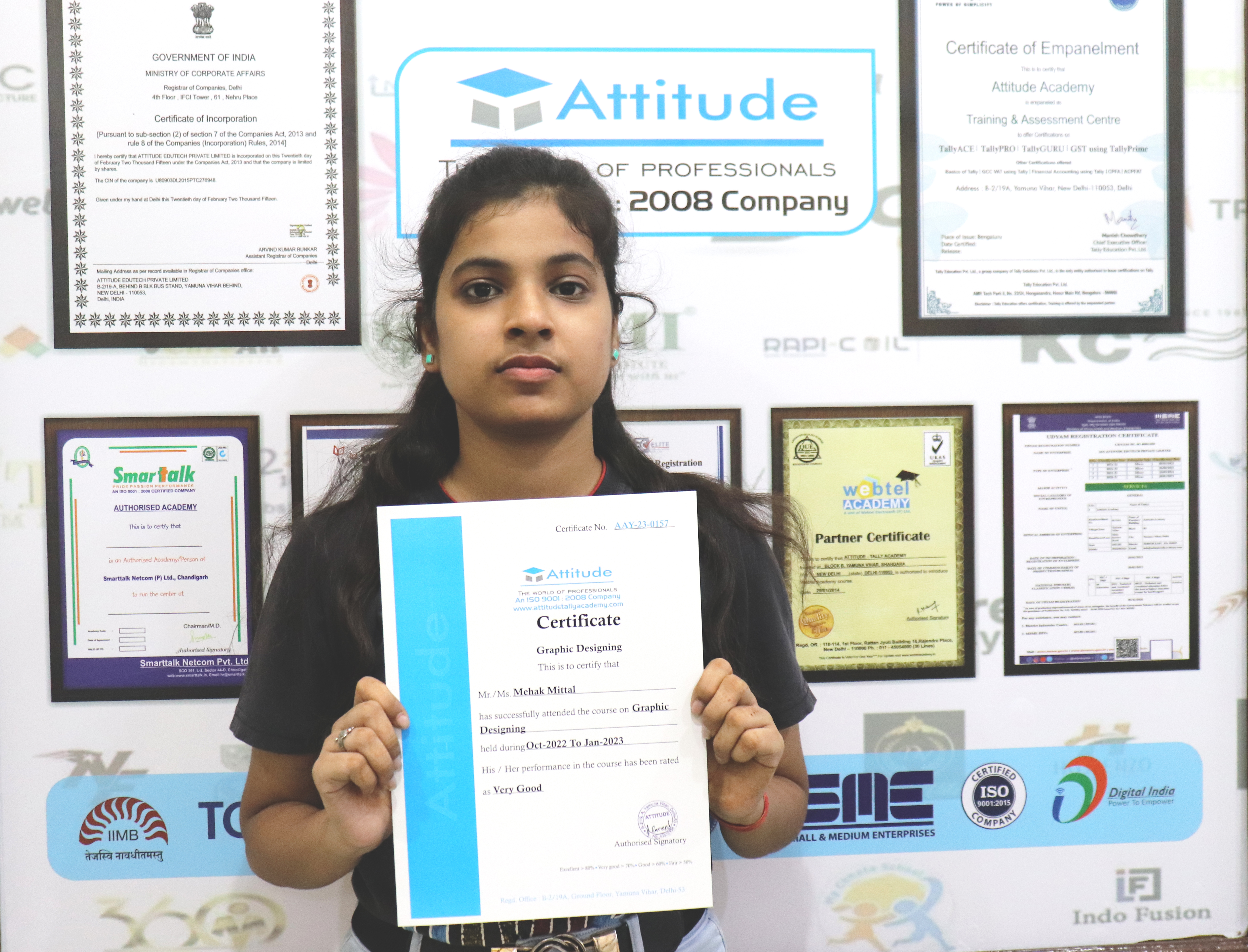
I had enrolled in the Graphic Designing training Course. The course was well taught by the trainer and the learning environment was great. they provide best and updated Study material and Give training on real industry assignments , they gi
This is one of the best institute for Graphic Designing and Web Designing Training. I recommend everyone should study from Shiraz Haider sir class and join his batch only, he is very knowledgeable and expert in this industry. He always expl
This is one of the best institute for Graphic Designing and Web Designing Training. I recommend everyone should study from Shiraz Haider sir class and join his batch only, he is very knowledgeable and expert in this industry. He always expl
This is one of the best institute for MIS Training. I recommend everyone should study from Soni Mam class and join her batch only, She is very knowledgeable and expert in this industry. She always explains the concepts very clearly and prov

It has been a great experience for me to take fashion and dress designing training from attitude academy. I have taken fashion and dress designing course .the trainer especially anjali mam is very good and has good knowledge. I have also go

Attitutde Academy is undeniably the best place for AutoCAD training institute in Yamuna Viahr, and I wholeheartedly endorse Sumit Sir's class. His expertise and industry knowledge are unparalleled. Sumit Sir excels in delivering crystal-cle
I recently completed the Interior Designing training course at Attitude Academy, and it exceeded my expectations. The trainer's expertise and the excellent learning environment made the experience remarkable. The study material was top-notc

It has been a great experience for me to take Autocad 3d's Max training from Attitude Academy. I have taken Autocad course. The trainer especially Sumit Sir is very good and has good knowledge. I have also got a placement from here. The pla

AutoCAD course was a fantastic opportunity for me to learn lots of new things and I am so delighted that I could have this course since I always wanted to go through this course. From the very first moment that I started the course I tried

It has been a great experience for me to take Autocad 3d's Max training from Attitude Academy. I have taken Autocad course. The trainer especially Mohsin Sir is very good and has good knowledge. I have also got a placement from here. The pl

I had enrolled in the Interior Designing training Course. The course was well taught by the trainer and the learning environment was great. they provide best and updated Study material and Give training on real industry assignments , they

It was such a great experience to study AutoCAD course, I have learned a lot about my strengths and weaknesses with the help of my amazing tutors. Now I believe I am more capable of teaching different skills effectively.
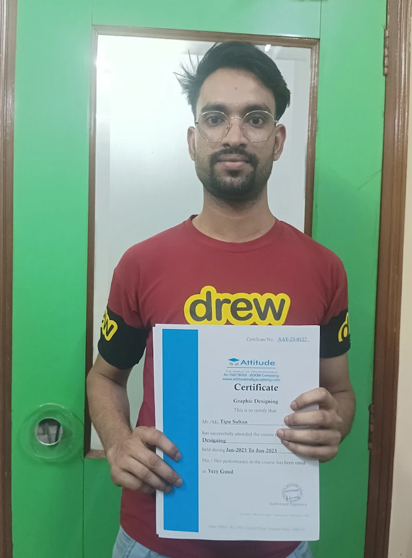
Attitude Academy is great place to learn. It gives me great to say with pride that, I have completed my Graphics Designing Course from Attitude Academy. The relationship between facilities and student is very cordial, which gave me an oppor

I am proud that I could participate this amazing course at the amazing Attitude Academy. It was an honor to work with knowledgeable tutors who helped us in all the ways possible. All I can say is Thank you Attitude Academy!
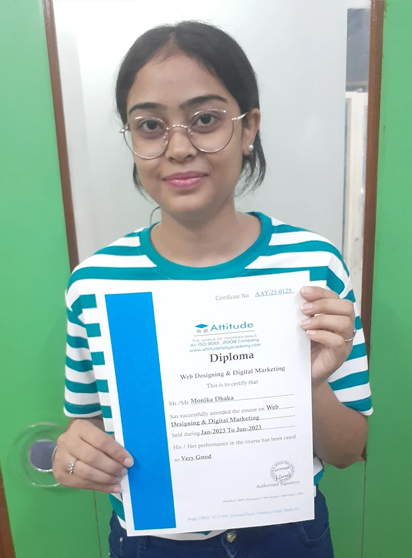
This course was a fantastic opportunity for me to learn lots of new things and I am so delighted that I could have this course since I always wanted to go through this course. From the very first moment that I started the course I tried to

This is ine of the beat institute for AutoCAD Training. I recommend everyone should study from Mandeep Sir class and join his batch only, he is very knowledgeable and expert in this industry he always explain the concept very clearly and pr

I am proud that I could participate this amazing course at the amazing Attitude Academy. It was an honor to work with knowledgeable tutors who helped us in all the ways possible. All I can say is Thank you Attitude Academy!
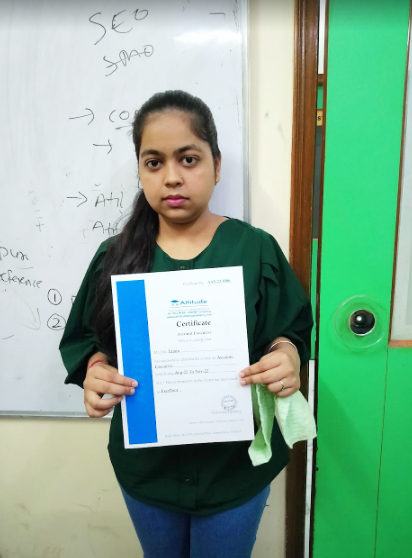
Attitude Academy is a practical technical institute and offers an ideal study environment for those who want experience both professionally and educationally. I found myself what I want to do in the future – to become an Accountant. I rea

3 weeks ago NEW I enjoyed the course because the tutors are enthusiastic people who put an effort to let students' understand the materials and they showed me that it is enjoyable to be a teacher. Attitude Academy is very helpful and prov

Being a student at Attitude Academy Yamuna Vihar as a super over experience. I am perceiving in financial accounting course I spend six month in this institute. I learnt so many things here there is not been academic also extra curriculum a

Attitude Academy is great place to learn. It gives me great to say with pride that, I have completed my Graphics Designing Course from Attitude Academy.The relationship between faculities and student is very cordial, which gave me an opport
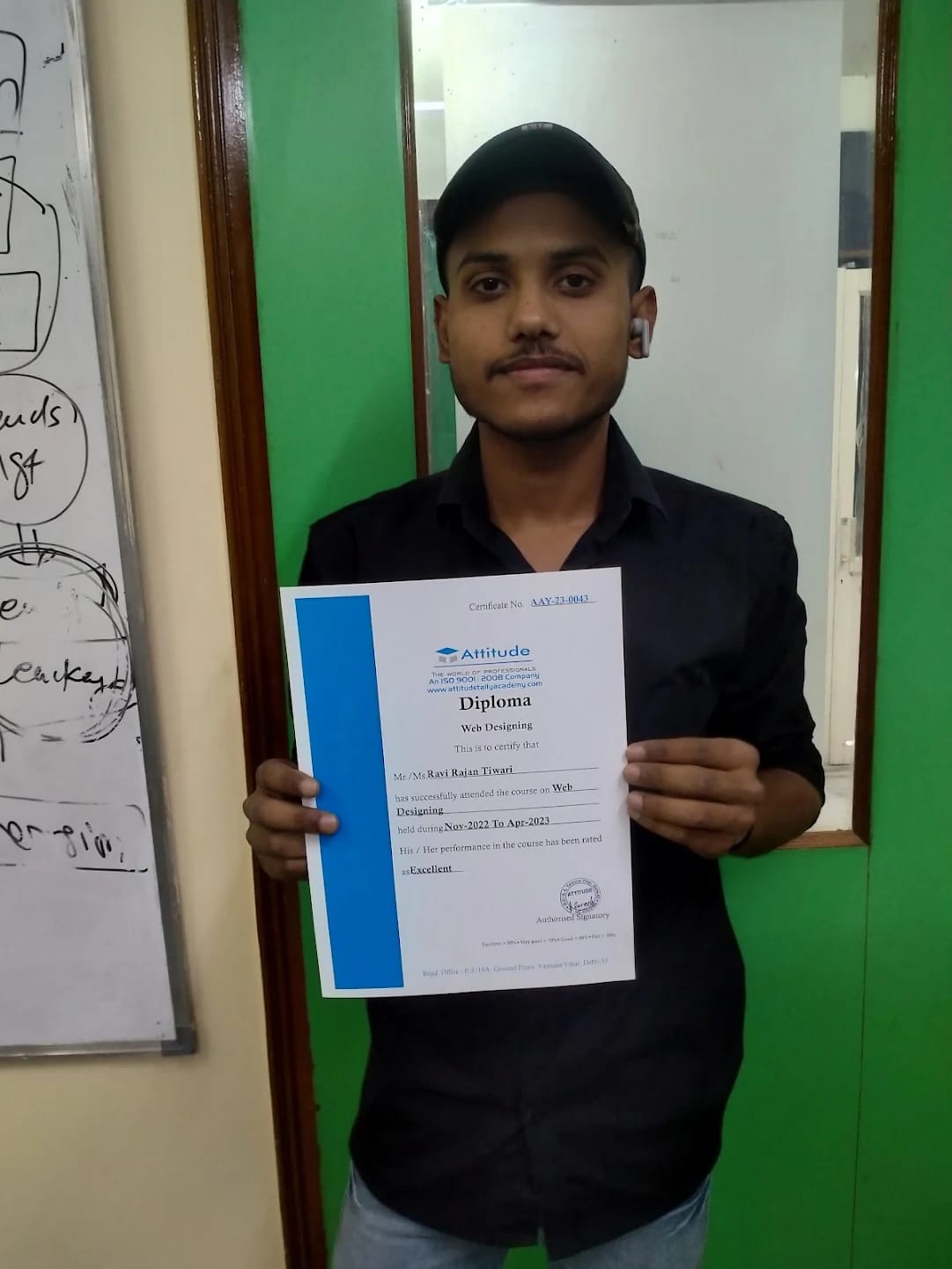
It has been a great experience for me to take Website designing training from Attitude Academy. I have taken Website Designing and development course. The trainer especially Shiraz Sir is very good and has good knowledge.

It has been a great experience for me to take Digital Marketing training from Attitude Academy. I have taken Digital Marketing Classes. The trainer especially Naresh Sir is very good and has good knowledge. I have also got a placement from

This is one of the best institute for BOC Training. I recommend everyone should study from Ruchika Mam class and join her batch only, She is very knowledgeable and expert in this industry. She always explains the concepts very clearly and p

I have got certified by Attitude Academy in Multimedia Expert course and I am very Thankful to Shiraz Haider sir & Team for supporting me. I am from Tamilnadu, taken Live classes & I have learnt successfully & got very good course material,

It's perfect for beginners. In this course, you can learn how to improve your designs and give them a professional look! job support is great tool of attitude academy i love it.... thanks for helping me in my first job placement
.png)
I've been learning and working in graphic design for many years. I actually picked up so many tips to make my designs look better! I love that trainer is always saying the shortcuts and where to find certain things in the programs. I have n

Had a great experience with the course, the classes touch upon both the functional and theoretical aspects of programming, and the care in responding to questions as well as obvious dedication to continue updating and improving the course a

Very professional. Honestly, this is about 2 courses worth of python in 1 course (in my opinion). Good pace, clear content, builds on each topic.

This course was one of few courses in python which i took. I must say nothing was more comprehensive and exhaustive like this. Attitude Academy goes into each and concept and talks about it in detail. At times it was overbearing but if you
.png)
Yes, This is the good session for me. I learned multiple things in this session like sentence formation, how can i used a,an,the articles and wh questions like where, who, what, how.....
.png)
i joined the english speaking course because i wanted to learn english properly and improve my level of english .when i joined udemy ,i experienced a lot of thing and i gained a lot of knowledge about english. i got confidence too and now i
.png)
This MS Excel course is very student friendly and easy to cope up with our daily work schedule.attitude academy has done an excellent job in presenting the content in simple way covering almost all the topics from beginner level to VBA.

While starting the course I was lacking motivation but as I learned to go with flow and explored different topics, faculty at Attitude Academy helped me by taking care of all the doubts. Thus, ensuring my clarity in the subjects.

My experience with Attitude Academy has been great. Now, I can say that I have a strong foundation in programming, This course gave me a taste of developing websites which helped me build some interesting projects for my portfolio.

I have completed the Android Development Course from Attitude Academy and it has been a game-changer in my life. The topics and assignments in the course were the key aspects that transformed my knowledge about Android Studio. Thanks Attitu
My experience with Attitude Academy has been amazing. The course gave immense knowledge about the subject which helped me gain confidence in learning the complex topics. I have had exceptional mentor support from Attitude Academy.

Best academy for smart courses and good facilities

one of the best institute have ever seen .... even teachers are so much coperative... online class LMS portal is best for learning

Attitude Academy is one of the best Academy to learn Tally, GST, Basic of Computers. Faculty of this institute are very cooperative, polite and humble with their students. The best part of this institute is they provide online lerning fac

Attitude academy is the best institute of Tally ERP9 with GST and Accounting in delhi. trainers are very helpful.

I am learning sketching here by Divya mam in this institute in fashion designing course..

i am an accountant by profession and the hole credit goes to Attitude tally academy , specially Turab sir.. here i got basic to excellence knowledge of accounting

Excellent institute. I would like to recommend it to everyone l know.

Nice fashion design academy in uttam nagar. Iam doing my dress and fashion design course from attitude academy in uttam nagar thanks to all my friends.

One of the good thing about this academy is that students have the opportunity to work on live projects & online classes also, which is industry's current demand.

Hi, My name is Sumant. I am a student of Attitude Academy. I am Learning Advance MS Excel here. Teachers are very supported. Overall good experience here & online LMS is best of this academy.
I am very much impressed with the faculty, the way of teaching and the most important and impressive is the real time project work which is 100% practical.
Wonderful dresses I am stitching for myself, my family and the institute, after learning dress designing from this institute. So happy...
Best FD and DD, I am doing 6 months course from here, Anjali and Divya mam are best. Such an experienced and great faculty of fashion and dress designing here.
Mamta mam is best Tally GST Taxation trainer. Learning e-accounting in this institute in a better way.

I have Completed my Tally.ERP9 Course with good experience. And now I feel that I am very confident about my interview and job.